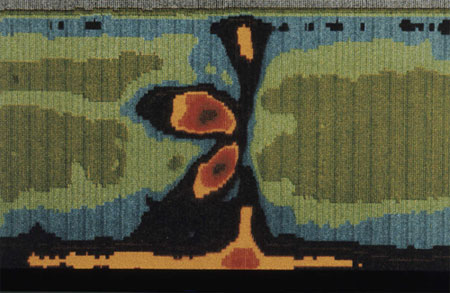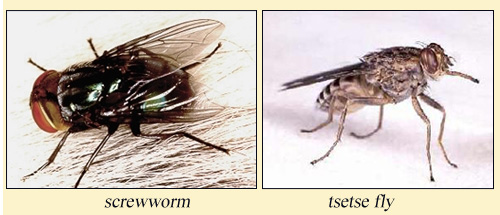Radioactivity applications in industry, food, everyday life
Well-controlled applications of radiations in industry, which enter in the fabrication of many finished products of our daily lives, are largely unnoticed by their consumers. These radioactive processes involving sources and tracers, are a vital step in the quality control of numerous industrial techniques.
These are non-destructive checks which do not disturb the production cycles.
A good example is the use of tiny amounts of argon 41 in oil refineries. This radioactive isotope is frequently injected into the catalytic cracking towers to better monitor the quality of oil produced. Engineers thus monitor and improve the quality of gasoline intended for the fuel tanks of motorists of our cars.

Gammadensimetry of a pile of wooden beams
This graph of comparative density, made using gamma ray imaging (a technique known as gammadensimetry), shows the areas of weakness (knots in the wood, beginnings of branches) in a plank.
© CEA
Radioactive sources are also frequently used to supervise industrial processes. In the cement industry, for example, large wagons carrying raw material are passed in front of a neutron source. The nuclei in the sample absorb these neutrons, and release the excess energy by emitting high-energy gamma rays. The detection of these rays allows for a better understanding of the sample composition, which can then be altered to suit the factory standards.
Radioactivity is also used to modify, through much higher doses of radiations, the mechanical and chemical properties of a material. An industrial process, similar to that used for restoring old furniture, transforms soft wood into nto panelling as hard as marble. These resistant parquet floors find their use in places with large passages, such as airports, public places, department stores or museums, for example in Paris the large evolution gallery at the Museum of Natural History.

Eradication of insects dangerous to man
Apart from the many programs to eradicate insects dangerous to agriculture, SIT has shown its success in the health field. The American department of agriculture has eliminated the screwworm in the United States and South America, a fly which feds itself on blood and attacked livestock and humans by infecting wounds. The IAEA has eradicated the tsetse fly in Zanzibar that also attacked the livestock and was the cause for the sleeping sickness in humans.
© DR
Irradiation by gamma rays has a number of applications in agriculture and food industry. While naturally-occurring rays do not have the energy needed to make atoms radioactive, they do have an impact on the sub-molecular world. The most common uses of radiations in the food-growing industry is to help remove insects and bacteria from fruits and vegetables. Either by killing them directly, or by sterilising the entire male population, insect-related problems can frequently be solved with no harm to the product involved.
In a quite different domain, gamma radiations are used to desinfect and desinsect relics of our past, such as for instance in 1977 the mummy of the Pharaoh Ramses II. High radiations doses get rid the mummy of its larvae, insects, fungi calamities.
Articles on the subject « Applications of Radioactivity »
Material Developmnent
Improvements in the quality of industrial products Every day we make use of products that have be[...]
Non Destructive Testing
Control of industrial processes and materials Tracers and radioactive sources are frequently used[...]
Food processing
Eradicate bacteria, fungi and pests with radiation … Gamma rays are used industrially to en[...]
Food Preservation
Conservation and preservation of food The effects of radiation on the cells of living or vegetabl[...]
Conservation Effects
A conservation process without additives, non radioactive The biological effects of strong doses [...]
Medfly Eradication
The curse of the medfly and its eradication The Mediterranean flies or Medflies are a dreadful cu[...]
Disinfecting Effects
Getting rid of parasites and germs….. The radiobiological action of radiation leads to damage to [...]
Radioactive Gauges
Instruments for industrial process control In order to be peforming and efficient; modern industr[...]
Sources in Industry
A wide variety of applications Most radioelements in radioactive sources are extracted from small[...]
Various Applications
Because of the fears it inspires, radioactivity is considered in the collective unconscious as ho[...]